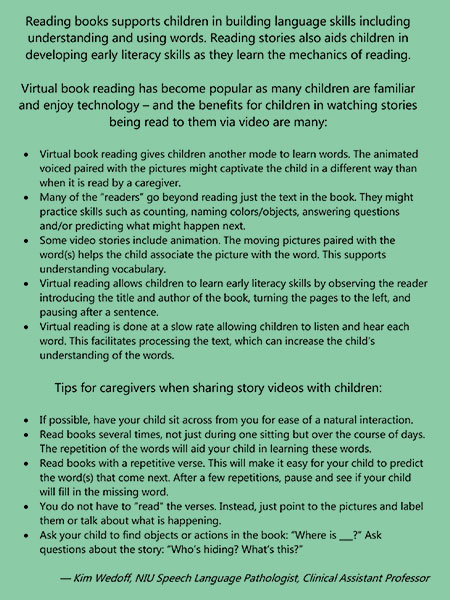
As schools closed across the country for COVID-19, celebrities quickly found a new calling.
Betty White, Michelle Obama, Josh Gad, Demi Lovato, Jimmy Fallon, Reese Witherspoon and countless other famous faces sat in front of cameras to engage in an online version of the cherished tradition in classrooms, libraries and bookstores: the read-aloud.
“It really came from just being so isolated and feeling like you just really wanted to connect with other people,” says Peet Smith, an assistant professor in the Department of Curriculum and Instruction.
“One of the ways that we sort of connect with each other – and I know that I still enjoy it, even as a 37-year-old person – is being read aloud to,” she adds. “There’s something really comforting there. We’re connecting with others in a time when we’re finding that so impossible.”
Melanie Walski agrees.
“In my classes with undergrads, I’ll read aloud picture books to them, and they’re always like, ‘Wow, this is so amazing!’ – and they’ll ask me, ‘What age is this for?’ ” says Walski, an assistant professor. “And I say, ‘Well, you liked it.’ ”
Whether consciously promoting or reinforcing their “brand” or simply wanting to help, the stars aptly demonstrated what it looks and sounds like to love reading.

Teachers and professors of Literacy Education – NIU’s Mary Gardner included – have been thrilled to watch the video trend spread like wildfire as it underscores of the power of reading and the ability of good literature to teach about the human condition and the world around us.
And, thanks to easy access to technology, everyone can participate.
Classroom teachers suddenly working remotely saw it as “the first thing to grab onto,” says Gardner, an instructor in the department and director of the Jerry L. Johns Literacy Clinic. “It was fairly easy to do once they figured out, ‘We can Zoom with our class.’ ”
“For many classroom teachers, read-aloud is a foundation, and to get back to that one piece of normalcy was important, and I think it was probably very important for their students. It’s like comfort food,” she says. “That whole read-aloud environment builds classroom community, and that’s the very thing they were missing.”
Reading fiction – “It’s magic,” Gardner says – adds the final ingredient to the recipe for success.
“It’s suspending reality,” Walski says. “Reality isn’t so normal right now, and it helps the kids escape into this beautiful fantasy world. Whether it be a picture book, where the teacher’s showing the illustrations, or a chapter book, like ‘James and the Giant Peach,’ where they’re getting to imagine it, the kids get that little break.”
Smith calls fiction “a comfort and distraction.”
“I know that I want a break every day from watching the news or hearing what’s going on, so I’m reading a lot more of the books I wanted to read that are fiction,” Smith adds. “I’m getting into a different world that I think can make us a little bit happier in a time when it’s tough to be happy.”
Even sad books provide an important and welcome escape, says Gardner, who remembers how she always wept while reading “Charlotte’s Web” to her classes.

NIU College of Health and Human Sciences
“And I think that’s OK,” she says. “If it’s a well-written book, you are with that character – you’re experiencing that – and you hate for the book to end. The read-aloud is a way to pass on that feeling.”
Literature, of course, is an excellent teacher of children.
They gain critical exposure to language, learning how words in text differ from those in regular conversation. They kindle their curiosity. They build their vocabulary. They explore, interpret and discover meaning through context.
They also find avenues toward understanding their states of mind, Smith says.
“Kids are trying to make sense of their emotions right now,” she says, “and I think that these books are way for them to sort of validate those things that they’re feeling.”
Gardner, Smith and Walski all have found favorites.
For Gardner, it’s Julie Andrew and her “Julie’s Library” podcasts with her daughter, Emma Walton Hamilton – “They’re picking some interesting books,” she says – as well as Rockford morning meteorologist Aaron Wilson.
 Smith has enjoyed watching the work of actresses Jennifer Garner and Amy Adams, whose “SaveWithStories” Instagram account features an array of celebrities reading aloud and raises funds for the Save the Children and No Kid Hungry charities.
Smith has enjoyed watching the work of actresses Jennifer Garner and Amy Adams, whose “SaveWithStories” Instagram account features an array of celebrities reading aloud and raises funds for the Save the Children and No Kid Hungry charities.
Walski is checking out “James and the Giant Peach,” an online read-aloud project helmed by filmmaker Taika Waititi. Actors Cate Blanchette, Benedict Cumberbatch, Eddie Redmayne and Meryl Streep are among the readers.
“Celebrities have a really wide-reaching audience,” Walski says. “In that sense, this has been really valuable because they can introduce kids to books that many they had never seen or heard about before.”

